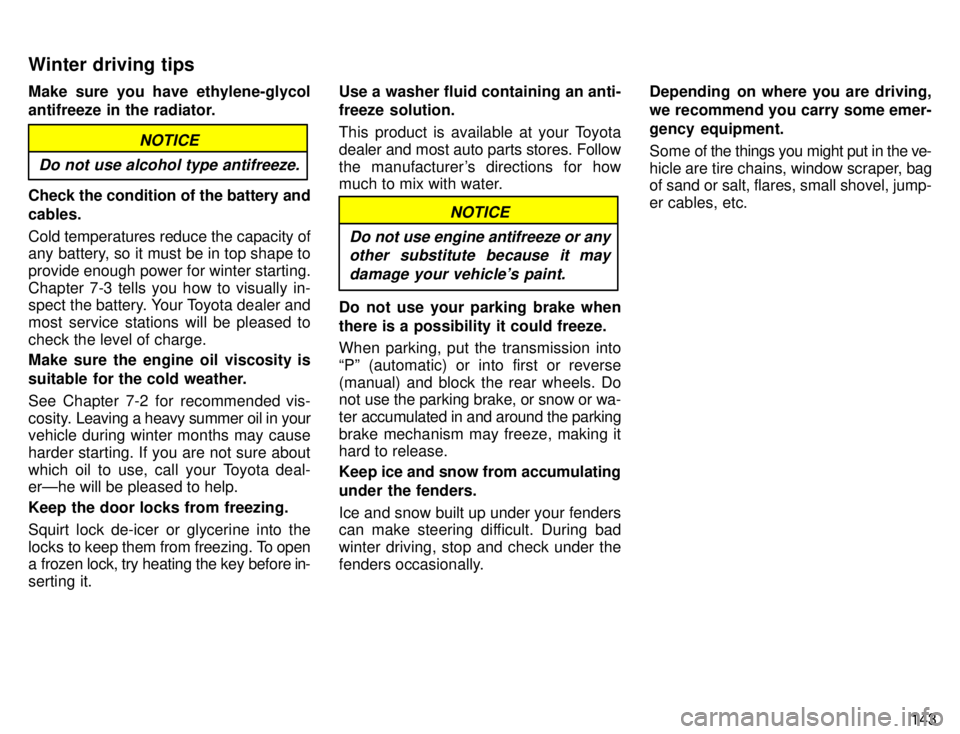1996 TOYOTA 4RUNNER oil viscosity
[x] Cancel search: oil viscosityPage 135 of 217

132
FUNCTIONS OF ENGINE OIL
Engine oil has the primary functions of lu-
bricating and cooling the inside of the en-
gine,
and plays a major role in maintaining
the engine in proper working order. ENGINE OIL CONSUMPTION
It is normal that an engine should con-
sume some engine oil during normal
engine operation. The causes of oil
consumption in a normal engine are
as follows. � Oil is used to lubricate pistons, piston
rings and cylinders. A thin film of oil isleft on the cylinder wall when a piston
moves downwards in the cylinder.
High negative pressure generated
when the vehicle is decelerating sucks
some of this oil into the combustion
chamber. This oil as well as some part
of the oil film left on the cylinder wall is
burned by the high temperature com-
bustion gases during the combustionprocess. �
Oil is also used to lubricate the stems
of the intake valves. Some of this oil is
sucked into the combustion chamber
together with the intake air and is
burned along with the fuel. High tem-perature exhaust gases also burn the
oil used to lubricate the exhaust valve stems.
The amount of engine oil consumed
depends on the viscosity of the oil, the
quality of the oil and the conditions
the vehicle is driven under. More oil is consumed by high-speed driv-
ing and frequent acceleration and decel- eration.
A new engine consumes more oil, since
its pistons, piston rings and cylinder walls
have not become conditioned.
When judging the amount of oil con-
sumption, note that the oil may be-come diluted and make it difficult to
judge the true level accurately.
As an example, if a vehicle is used for re-
peated short trips, and consumes a nor- mal amount of oil, the dipstick may not
show any drop in the oil level at all, even after 1000 km (600 miles) or more. This is because the oil is gradually becoming
diluted with the fuel or moisture, making it
appear that the oil level has not changed. The diluting ingredients evaporate out
when the vehicle is then driven at high
speeds, as on an expressway, making itappear that oil is excessively consumed
after driving at high speeds.
IMPORTANCE OF ENGINE OIL LEVEL CHECK
One of the most important points in proper vehicle maintenance is to keep the engine
oil at the optimum level so that oil function
will
not be impaired. Therefore, it is essen-
tial that the oil level be checked regularly.
Toyota recommends that the oil level bechecked every time you refuel the vehicle.
NOTICE
Failure to check the oil level regular- ly could lead to serious engine
trouble due to insufficient oil.
For detailed information on the oil level
check, see Checking the engine oil levelº
in Chapter 7-2.
Facts about engine oil consumption
Page 146 of 217

143
Make sure you have ethylene-glycol
antifreeze in the radiator.
NOTICE
Do not use alcohol type antifreeze.
Check the condition of the battery and cables. Cold temperatures reduce the capacity of
any battery, so it must be in top shape to provide enough power for winter starting.Chapter 7-3 tells you how to visually in-
spect the battery. Your Toyota dealer and
most service stations will be pleased tocheck the level of charge.
Make sure the engine oil viscosity is
suitable for the cold weather.
See Chapter 7-2 for recommended vis-
cosity. Leaving a heavy summer oil in your
vehicle during winter months may cause
harder starting. If you are not sure about
which oil to use, call your Toyota deal- erÐhe will be pleased to help. Keep the door locks from freezing. Squirt lock de-icer or glycerine into the
locks to keep them from freezing. To open
a frozen lock, try heating the key before in-serting it. Use a washer fluid containing an anti-
freeze solution.
This product is available at your Toyota
dealer and most auto parts stores. Follow
the manufacturer's directions for how
much to mix with water.
NOTICE
Do not use engine antifreeze or any other substitute because it may
damage your vehicle's paint.
Do not use your parking brake when there is a possibility it could freeze. When parking, put the transmission into
Pº (automatic) or into first or reverse
(manual) and block the rear wheels. Do
not use the parking brake, or snow or wa-
ter accumulated in and around the parkingbrake mechanism may freeze, making it
hard to release. Keep ice and snow from accumulating
under the fenders.
Ice and snow built up under your fenders
can make steering difficult. During bad winter driving, stop and check under the
fenders occasionally. Depending on where you are driving,
we recommend you carry some emer- gency equipment.
Some of
the things you might put in the ve-
hicle are tire chains, window scraper, bag of sand or salt, flares, small shovel, jump- er cables, etc.
Winter driving tips
Page 187 of 217

184�
Do not drive with the air cleaner fil-
ter removed, or excessive engine
wear could result. Also backfiring
could cause a fire in the enginecompartment.
�Be careful not to scratch the glass
surface with the wiper frame.
�When closing the engine hood,check to see that you have not for-
gotten any tools, rags, etc.
Here is a list of parts and tools you will
need on performing do-it-yourself main-
tenance. Remember all Toyota parts are
designed in metric sizes, so your tools
must be metric. Checking the engine oil level Parts (if level is low): � Engine oil API SH, Energy-Conserv-
ing IIº multigrade or ILSAC multigrade
having viscosity proper for your cli-mate
Tools: � Rag or paper towel
� Funnel (only for adding oil)
Checking the engine coolant level Parts (if level is low): � Ethylene-glycol antifreeze
� Demineralized or distilled water
Tools: � Funnel (only for adding coolant)
Checking brake fluid Parts (if level is low): � SAE J1703 or FMVSS No. 116 DOT 3 brake fluid
Tools: � Rag or paper towel
� Funnel (only for adding fluid) Checking power steering fluid Parts (if level is low): �
Automatic transmission fluid DEX- RON [
-II or -III
Tools: � Rag or paper towel
� Funnel (only for adding fluid)
Checking battery condition Non-maintenance batteriesÐ
Tools: � Warm water
� Baking soda
� Grease
� Conventional wrench (for terminal clamp bolts)
Maintenance type batteriesÐ Parts (if level is low): � Distilled water
Tools:� Warm water
� Baking soda
� Grease
� Conventional wrench (for terminal clamp bolts)
� Coin (for vent plugs)
� Funnel (only for adding distilled water)
Parts and tools
Page 191 of 217

188ENGINE OIL SELECTION Use API SH, Energy-Conserving IIº mul- tigrade engine oil or ILSAC multigrade en-
gine oil. Recommended viscosity (SAE):
SAE 5W-30 is the best choice for your
vehicle, for good fuel economy and
good starting in cold weather.
If you use SAE 10W-30 engine oil in
extremely low temperatures, the en-
gine may become difficult to start, so
SAE 5W-30 engine oil is recom-mended.
API service symbol
ILSAC certification mark
Oil identification marks
Either or
both API registered marks are
added to some oil containers to help
you select the oil you should use.
The API Service Symbol is located any-
where on the outside of the container. The top portion of the label shows the oil
quality by API (American Petroleum Insti-
tute) designations such as SH. The center
portion of the label shows the SAE viscos-
ity grade such as SAE 5W-30. Energy-
Conserving IIº shown in the lower portion,
indicates that the oil has fuel-saving ca-
pabilities. Oils marked Energy-Conserv-
ing IIº will have higher fuel-saving capa-
bilities than oils marked Energy- Conservingº.
The ILSAC (International Lubricant Stan-
dardization and Approval Committee)Certification Mark is displayed on the front
of the container.
Page 210 of 217

+20 -15207
5VZ-FE engine
Generator belt 100 + 20
Air conditioning compressor belt 100 + 20
Power steering
pump belt 100
ENGINE LUBRICATION
Oil capacity (drain and refill), L (qt., Imp. qt.): 3RZ-FE engine With filter 5.4 (5.7, 4.8)
Without filter 4.7 (5.0, 4.1)
5VZ-FE engine With filter 5.2 (5.5, 4.6)
Without filter 4.9 (5.2, 4.3) Oil grade:
API SH, Energy-Conserving IIº multi-
grade engine oil or ILSAC multigrade
engine oil is recommended.
Recommended oil viscosity (SAE):
COOLING SYSTEM
Total capacity, L (qt., Imp. qt.): 3RZ-FE engine
With rear heater 11.0 (11.6, 9.7)
Without rear heater
10.0 (10.6, 8.8)
5VZ-FE engine With rear heater
9.0 (9.5, 7.9)
Without rear heater 8.0 (8.5, 7.0) Coolant type:
With ethylene-glycol antifreeze (Do not use alcohol type.)
BATTERY ÐMaintenance type battery Specific gravity reading at 20 �C (68 �F):
1.280 Fully charged
1.180 Half charged
1.080 Discharged
ÐNon-maintenance battery Open voltage* at 20 �C (68 �F):
12.7 V Fully charged
12.3 V Half charged
11.9 V Discharged
*: Voltage that is checked 20 minutes af-
ter the key is removed with all the lights
turned off
Charging rates: Non-maintenance battery 5 A max. Maintenance type batteryQuick charge 15 A max.
Slow charge 5 A max.
CLUTCH
Pedal freeplay, mm (in.):
5Ð15 (0.2Ð0.6)
Fluid type:
SAE J1703 or FMVSS No. 116 DOT 3
Page 211 of 217

208MANUAL TRANSMISSION
Oil capacity, L (qt., Imp. qt.):
3RZ-FE engine Two-wheel drive models 2.6 (2.7, 2.3)
Four-wheel drive models 2.5 (2.6, 2.2)
5VZ-FE engine
2.2 (2.3, 1.9)
Oil type: Multipurpose gear oil API GL-4 or GL-5
Recommended oil viscosity: SAE 75W-90
AUTOMATIC TRANSMISSION Fluid capacity (drain and refill), L (qt., Imp. qt.):
Two-wheel drive modelsUp to 1.6 (1.7, 1.4)
Four-wheel drive models Up to 2.0 (2.1, 1.8)
Fluid type:
Automatic transmission fluid DEXRON [
-II TRANSFER
Oil capacity, L (qt., lmp. qt.):
1.0 (1.1, 0.9)
Oil type: Multipurpose gear oil API GL-4 or GL-5
Recommended oil viscosity: SAE 75W-90
DIFFERENTIAL
Oil capacity, L (qt., lmp. qt.):
Two-wheel drive models2.75 (2.9, 2.4)
Four-wheel drive models
Front A.D.D.1.15 (1.2, 1.0)
Except A.D.D. 1.1 (1.2, 1.0)
Rear
With rear differential lock system 2.6 (2.7, 2.3)
Without rear differential lock system
2.35 (2.5, 2.1) Oil type:
Hypoid gear oil API GL-5
Recommended oil viscosity: Front A.D.D.
SAE 75W-90
Except A.D.D. Above -18 �C (0 �F)
SAE 90
Below -18 �C (0 �F)
SAE 80W or 80W-90
Rear Above -18 �C (0 �F)
SAE 90
Below -18 �C (0 �F)
SAE 80W or 80W-90
CHASSIS LUBRICATIONPropeller shafts:
SpidersLithium base chassis grease, NLGI No. 2
Slide yoke and double cardan joint Molybdenum-disulfide lithium basechassis grease, NLGI No. 2